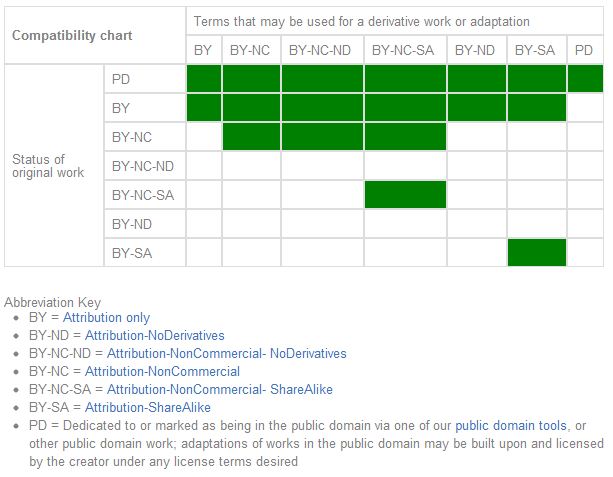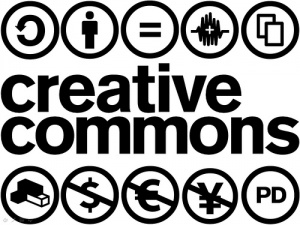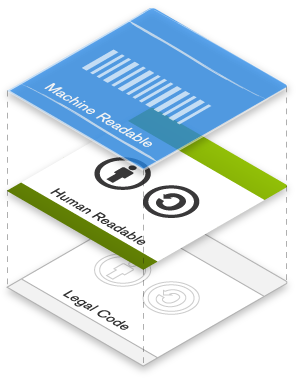Difference between revisions of "Creative Commons"
(→1. Attribution license(abbreviated to 'BY')) |
(→License Types) |
||
| Line 32: | Line 32: | ||
Creative Commons offers six licenses for use and all of the licenses require attribution when using the work but offer varying degrees of freedom regarding the users ability to copy and distribute it. | Creative Commons offers six licenses for use and all of the licenses require attribution when using the work but offer varying degrees of freedom regarding the users ability to copy and distribute it. | ||
| − | ===1. Attribution license ( | + | ===1. Attribution license ('BY')=== |
*Allows others to copy, distribute, display, and perform copyrighted work - and derivative works based upon it - but only as long as credit is given. <ref>http://www.flickr.com/creativecommons/</ref> <ref name = "Cliff Morgan"> Morgan, Cliff. "Understanding the Creative Commons Licence." Learned Publishing 24.1 (2011): 51-53. Print.</ref> | *Allows others to copy, distribute, display, and perform copyrighted work - and derivative works based upon it - but only as long as credit is given. <ref>http://www.flickr.com/creativecommons/</ref> <ref name = "Cliff Morgan"> Morgan, Cliff. "Understanding the Creative Commons Licence." Learned Publishing 24.1 (2011): 51-53. Print.</ref> | ||
| − | ===2. Attribution Share Alike ( | + | ===2. Attribution Share Alike (‘BY-SA’)=== |
*You allow others to distribute derivative works only under a license identical to the license that governs your work.<ref name = "Cliff Morgan"/> | *You allow others to distribute derivative works only under a license identical to the license that governs your work.<ref name = "Cliff Morgan"/> | ||
| − | ===3. Attribution No Derivatives ( | + | ===3. Attribution No Derivatives (‘BY-ND’)=== |
*You let others copy, distribute, display and perform only verbatim copies of your work, but not derivative works based upon it.<ref name = "Cliff Morgan"/> | *You let others copy, distribute, display and perform only verbatim copies of your work, but not derivative works based upon it.<ref name = "Cliff Morgan"/> | ||
| − | ===4. Attribution Non-commercial ( | + | ===4. Attribution Non-commercial (‘BY-NC’)=== |
*Is the attribution which dictates that the original work cannot be used for commercial purposes.<ref name = "Cliff Morgan"/> | *Is the attribution which dictates that the original work cannot be used for commercial purposes.<ref name = "Cliff Morgan"/> | ||
Revision as of 21:31, 10 December 2012
Creative Commons (CC) is a non-profit organization headquartered in Mountain View, California whose aim is to realize the full potential of the internet and drive a new era of development, growth, and productivity [1]. Creative Commons builds upon the already existing copyright protection, which is applied to any kind of work immediately after it is conceptualized. Copyright law grants an author right over their work from the moment of its conception. Furthermore, copyright law prohibits the making of copies without the rights holder’s permission. However, due to the nature of the internet, copyright is increasingly relevant because it is easy to violate the law. This creates many potential ethical problems. Creative Commons creates a free, public, and standardized infrastructure that creates a balance between the reality of the internet and the reality of copyright laws. Creative Commons provides an infrastructure which consists of a set of copyright licenses and tools that create a balance inside the traditional “all rights reserved” setting that copyright law creates. This is done using a simple standardized way so artists can choose which level of copyright protection they desire. This ability plays a large roll on the Internet because information can be easily and legally, copied, distributed, edited and built upon. Specifically, this is done using 6 difference creative commons license types which give owners varying degrees of copyright protection. Furthermore, CC is recognized globally and licenses apply to affiliates all over the world. CC is especially useful because its licenses and tools were designed to work specifically with the web, which is rapidly becoming the easiest and most convenient method for information sharing. In addition to its license, CC also offers legal tools such as CC0 which is a public domain dedication for rights holders who want to put their work in public domain in advance of the expiration of their copyright.
Contents
- 1 History
- 2 License Types
- 2.1 The Three Layer Concept
- 2.2 1. Attribution license ('BY')
- 2.3 2. Attribution Share Alike (‘BY-SA’)
- 2.4 3. Attribution No Derivatives (‘BY-ND’)
- 2.5 4. Attribution Non-commercial (‘BY-NC’)
- 2.6 5. Attribution Non-commercial Share alike (‘BY-NC-SA’)
- 2.7 6. Attribution Non-commercial No Derivatives (‘BC-NC-ND’)
- 2.8 CC Zero (CC0)
- 3 Criticism
- 4 Ethical Implications
- 5 Organizations That Use Creative Commons
- 6 See Also
- 7 External Links
- 8 References
History
Creative Commons was founded in 2001 in part using support by the Center of the Public Domain. Its organizational structure is a board of directors which consists of leaders who are education experts, technologists, legal scholars, investors, entrepreneurs and philanthropists. Currently, Creative Commons offices reside in San Francisco, California and current board consists of Hal Abelson, Glenn Otis Brown, Michel Carroll, Catherine Casserly (CEO), Caterina Fake, Brian Fitzgerald, David Guggenheim, Joi Ito (Chair), Lawrence Lessig, Laurie Racine, Eric Saltzman, Molly Shaffer Van Houweling, Annetter Thomas, Jimmy Wales, Esther Wojciki (Vice Chair). Creative Commons used to be lead by Lawrence Lesigg, however he stepped down in 2008 passing on the post to Joi Ito. However, currently Catherine Casserly in now CEO
Some of CC's major milestones:
| Year | Milestone |
|---|---|
| 2002 | CC released its first set of copyright licenses for free to the public and was inspired by the Free Software Foundation’s GNU General Public License. |
| 2003 | approximately 1 million licenses were in use, and by end of 2004 an estimated 4.7 licensed works were using CC. |
| 2009 | there were estimated 350 million CC licensed works, and Wikipedia migrated to CC Attribution – ShareAlike as its main content license. [2]. |
License Types
The Three Layer Concept
Creative Commons licenses are written in three "layers". This is done to make CC even easier to use. The first layer happens to be the legaleze that actually dictates the legal aspects of the license. Legal writing is often difficult and hard to read for most of the people that use Creative Commons so the company provides the second layer which is called the Commons Deed but is often referred to as the Human Readable version. This layer provides an easy way for the every day non-lawyer to understand what exactly the license allows for and covers. The third and final layer is the "machine readable" version. This allows for software and search engines to know what is available under a CC license. [3]Creative Commons offers six licenses for use and all of the licenses require attribution when using the work but offer varying degrees of freedom regarding the users ability to copy and distribute it.
1. Attribution license ('BY')
- Allows others to copy, distribute, display, and perform copyrighted work - and derivative works based upon it - but only as long as credit is given. [4] [5]
- You allow others to distribute derivative works only under a license identical to the license that governs your work.[5]
3. Attribution No Derivatives (‘BY-ND’)
- You let others copy, distribute, display and perform only verbatim copies of your work, but not derivative works based upon it.[5]
4. Attribution Non-commercial (‘BY-NC’)
- Is the attribution which dictates that the original work cannot be used for commercial purposes.[5]
- Is similar to BY-SA, but with restriction that further uses can only be non-commercial.[5]
6. Attribution Non-commercial No Derivatives (‘BC-NC-ND’)
- Similar to BY-NC, but original material cannot be changed or adapted in any way. This license is the most restrictive of the six main licenses. The work cannot be used commercially, nor can it be altered in any manner. [6] [5]
CC Zero (CC0)
CC zero or CC0 was introduced in 2008 and waives all copyright and puts material straight into the public domain, with no restrictions as to use.
- Creative Commons Symbols

Criticism
The most common criticism of the creative commons license is that the creativity of individuals can be exploited by others without investing as much time in creating original content. This idea lumps those using the creative commons license into the mindset of rehashing old work without contributing anything novel. Furthermore, because of the low amount of official administration under creative commons, many people can abuse works under its license by claiming others' work to be their own. Smaller groups of content production, like bloggers or small news publications, can be greatly affected by others taking their work under the Creative Commons license and reusing it.
Criticism with creative commons occur in several distinct areas:
- While Creative Commons is revolutionary in design, its success depends on users being able to read and understand copyright protection properly. This situation is at large and widespread and can even be attributed to companies like Wired.com. Upon closer research of Wired.com use of images almost 80% are allowed only under noncommercial use: however WIRED is a private for-profit entity, and earns money from site's advertising revenue. Furthermore, Wired urges to viewers to use images and allows them in blogs, but specifies not to use in advertisements. However, this is in conflict with the rights of property which is used under the noncommercial license. If content is copyrighted in such a way, the owner forgoes any profits associated with content because it is not allowed commercially. This example presents a major lack of understanding of what creative commons licenses entail. [7].
- Anti-Public Domain – One critique of Creative Commons is that creative common licenses confuse notions of what the public domain and what the common is, and therefore contribute to the decline of the public domain. According to Susan… she argues that authors need to understand what is meant by the public domain, and beliefs about what the legal definition depend on preconception of what the public domain is. Since creative commons blurs the line between these two separate spaces for information it is argued that creative commons takes away from content in the public domain.
- Distinction between commercial and non-commercial is unclear: Another critique is that what is allowed to be used commercially and non-commercially is not declared specifically and is a result of poor description in creative commons. Scenarios which represent this are as follows:
- Creative Commons licensed work is permitted to be used for non-commercial purposes and a university seeks to copy the work for student course pack of materials. While copying for education is allowed, it is not clear whether it is allowed under Creative Commons. Furthermore, since the work is being used by an educational institution does it follow that use is non-commercial. Next, if work is used on a website or blog which contains ads, is this allowed under non-commercial use? These questions are not clearly defined or answered in creative commons.
- Lack sufficient provision for moral rights protections: Another issue raised due to creative commons are the moral protections authors should have. According to Susan… these include an author’s right to attribution and right of integrity (the right not to have work subjected to derogatory treatment) However, under creative commons licenses it is possible to use an author’s work and build upon it and can reflect negatively upon creators because what they envisioned for their work can be altered and presented in a different form. Based on CC laws once a work is declared Creative Commons rights cannot be retracted and can have detrimental effects on potential professional careers. [8]
Ethical Implications
Because the Creative Commons relies on user collaboration in online environments, ethical concerns arise in the category of copyright credibility. Because the Creative Commons is a separate entity from other offline copyright organizations, they often are targeted for not being as strict as they should be.[9]
Organizations That Use Creative Commons
Al Jazeera
Al Jazeera started using CC in 2009 in order to create a site for hosting videos shot from Gaza which the public and other news organizations would have access to. They have also started a CC blog for journalists and correspsondents to right in.
Flickr
Flickr allows for users to license their photos under CC and currently has over 200 million CC-licensed photos making it the largest site for Creative Commons content.
Google has incorporated CC into many aspects of it's company. Users can search for CC content under Google Search, or license their work under CC through Google products such as Picasa, and Google Knol. Youtube also has a feature to allow for users to swap "All Rights Reserved" music for similar CC-licensed music.
Internet Archive
The Internet Archive allows users to search their content by which items are under Creative Commons Licenses. When submitting content to the sight, one can choose to put a Creative Commons License on the content, grating people the right to use the material in adherence to the rules of Creative Commons.
OpenCourseWare
MIT allows for its courses to be posted online for access under a CC license. Since MIT started doing this in 2004 other universities have followed suit.
Public Library of Science
The Public Library of Science publishes seven journals under a CC license.
SoundCloud
The popular social sound platform Soundcloud gives users the option to choose either a Creative Commons license or All Right Reserved. If the user chooses the Creative Commons license, they have the option to make their works be available for other users to share or modify based on which protection layer was chosen. [10]
Whitehouse.gov
The Obama Administration has used CC for campaign photos, and when releasing information onto the White House site. The White House site also requires third parties to license their works under CC if they're going to post information on the site.
Wikipedia
Wikipedia recently switched its content from a GNU Free Documentation License to a CC Attribution-ShareAlike license.[11]
Vimeo
The video-sharing site Vimeo gives users the option to choose from various levels of Creative Commons attribution licenses when publishing their videos online. A search of the 'creative commons' tag on Vimeo provides all the videos that have been licensed under a Creative Commons license.
See Also
External Links
References
- ↑ About http://creativecommons.org/about accessed December 04 2011.
- ↑ Board of Directors http://creativecommons.org/board accessed December 08 2011.
- ↑ License Types http://creativecommons.org/licenses/ accessed November 5 2011.
- ↑ http://www.flickr.com/creativecommons/
- ↑ 5.0 5.1 5.2 5.3 5.4 5.5 Morgan, Cliff. "Understanding the Creative Commons Licence." Learned Publishing 24.1 (2011): 51-53. Print.
- ↑ http://creativecommons.org/licenses/
- ↑ http://www.niemanlab.org/2011/11/consumers-of-creative-commons-licenses-do-not-understand-them-a-little-more-context-to-wireds-use-of-cc/
- ↑ Corbett, Susan. "Creative Commons Licences, the Copyright Regime and the Online Community: Is There a Fatal Disconnect?" The Modern Law Review 74.4 (2011). Print
- ↑ http://mako.cc/writing/toward_a_standard_of_freedom.html
- ↑ http://soundcloud.com/help/legal#what-is-creative-commons
- ↑ http://creativecommons.org/who-uses-cc Accessed December 17, 2011

